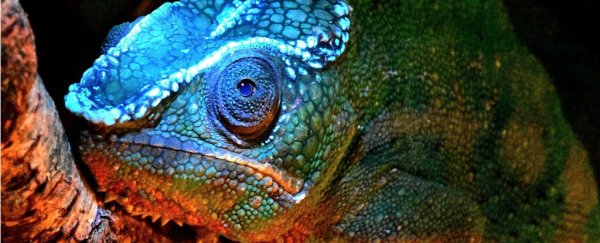All species have their own means of communicating, but chameleons, perhaps, are some of the strangest.
They use their unusual ability to change the colour of their skin - and now researchers have discovered that maybe they use their skulls to communicate, too.
A team of researchers led by David Prötzel, a PhD student at the Bavarian State Collection of Zoology, has shown that the reptiles' skulls fluoresce under ultraviolet light - right through their scaly skins.
The phenomenon is called biofluorescence - not to be confused with bioluminescence, the chemical process that many glow-in-the-dark sea creatures - and also fireflies - use to produce a glittering light show.
Biofluorescence is not a chemical reaction. In this case, living organisms absorb light and re-emit it in a different colour. For a human to see this effect, the organism needs to be illuminated by an external light source, such as a UV light bulb.
"So we could hardly believe our eyes when we illuminated the chameleons in our collection with a UV lamp, and almost all species showed blue, previously invisible patterns on the head, some even over the whole body," Prötzel said.
This effect is usually found in ocean creatures, and only rarely in terrestrial vertebrates, making chameleons all the more distinctive.
It's not the chameleon's entire skeleton that fluoresces through the skin, but a pattern of bony bits called tubercles that stick out from the surface of the head and spine. These tubercles are sexually dimorphic in shape and size.
However, scientists have never been able to figure out their purpose, which is why Prötzel and a team of researchers decided to take a closer look, using a variety of techniques to examine the tubercles.
It's actually been known for some time that bones fluoresce (that includes your teeth, by the way), but hidden as they usually are underneath layers of body tissue where they can't be reached by UV light, let alone emit any, it's not a particularly well-utilised characteristic.
In order for the bony bits to be visible in chameleons, the reptiles have a second trick up their sleeves.
"The tissue analyses yielded another surprise," said co-author Martin Heß of the BioCenter of Ludwig-Maximilians-Universität in Munich.
"Our histological 3D reconstruction shows that the skin covering the tubercles on the skull is very thin and consists only of a transparent layer of epidermis.
"These patches effectively act as windows that enable UV light to reach the bone, where it is absorbed and then emitted again as blue fluorescent light."
This discovery might finally provide an explanation for those tubercles. Each species of chameleon has a different and very distinct configuration of them. In addition, males have considerably more spiky protrusions than females.
And chameleons can see ultraviolet light, which means it's likely the reptiles can see those patterns on each other. So, they could be using them to communicate.
The researchers believe the patterns could be used to help chameleons recognise others of their own species, attract a mate, and find other chameleons - especially since blue is a relatively uncommon colour in the forests chameleons call home.
The research has been published in the journal Scientific Reports.
